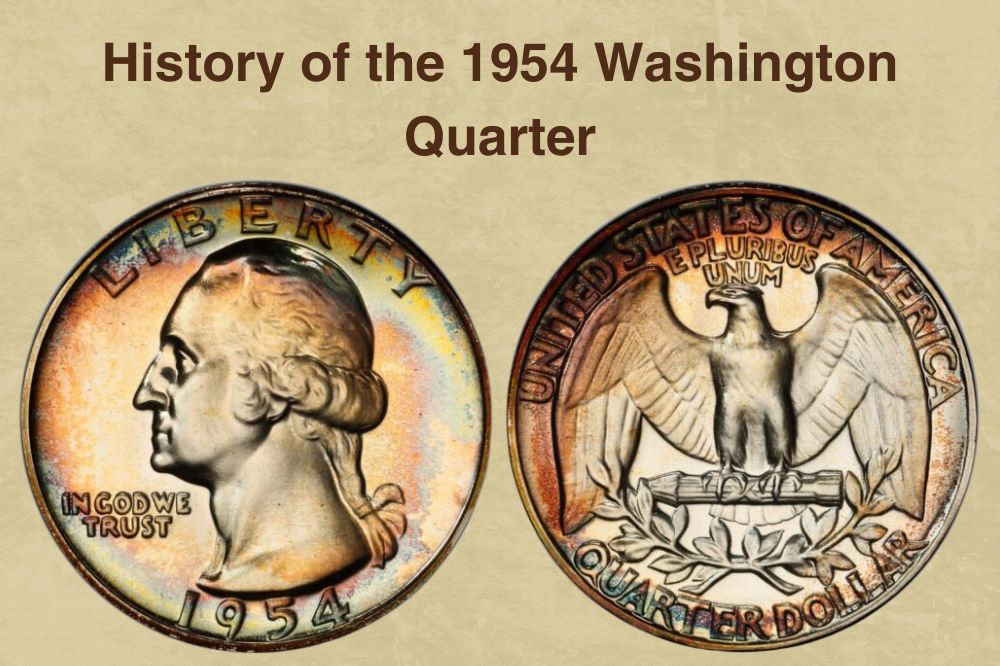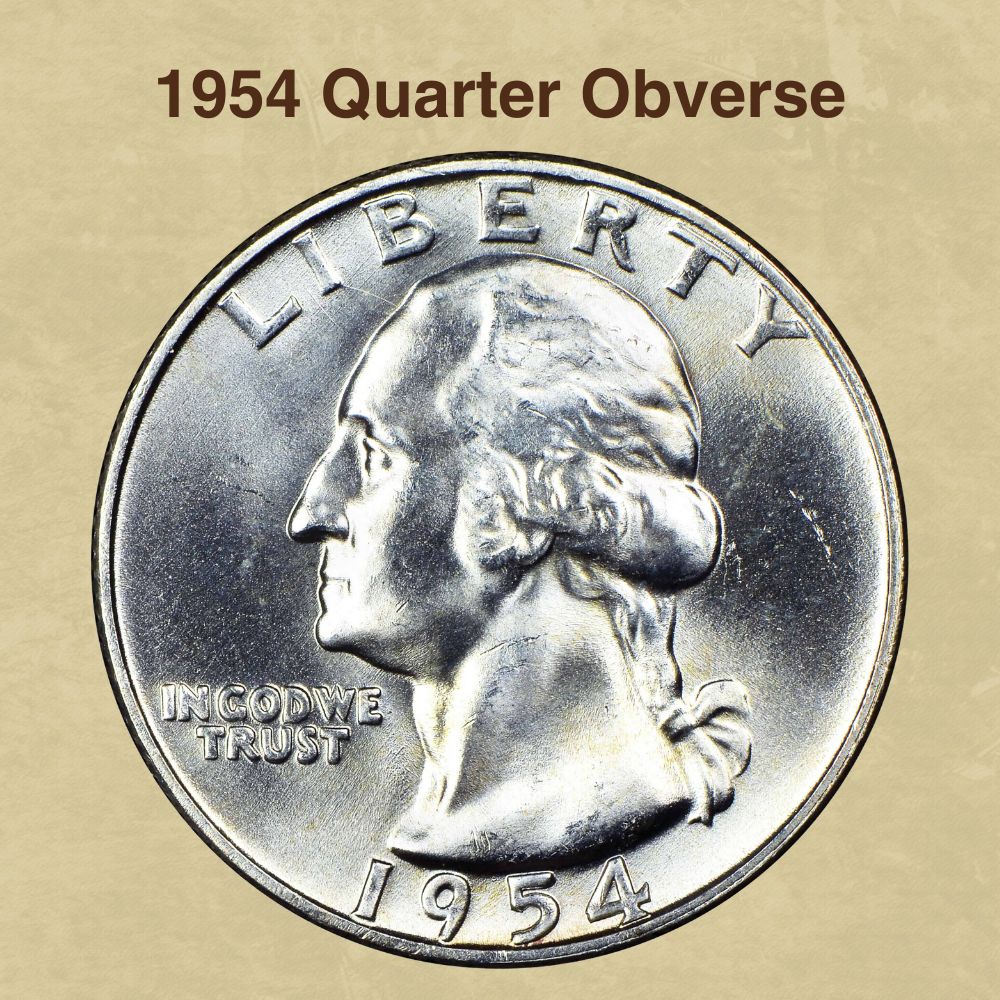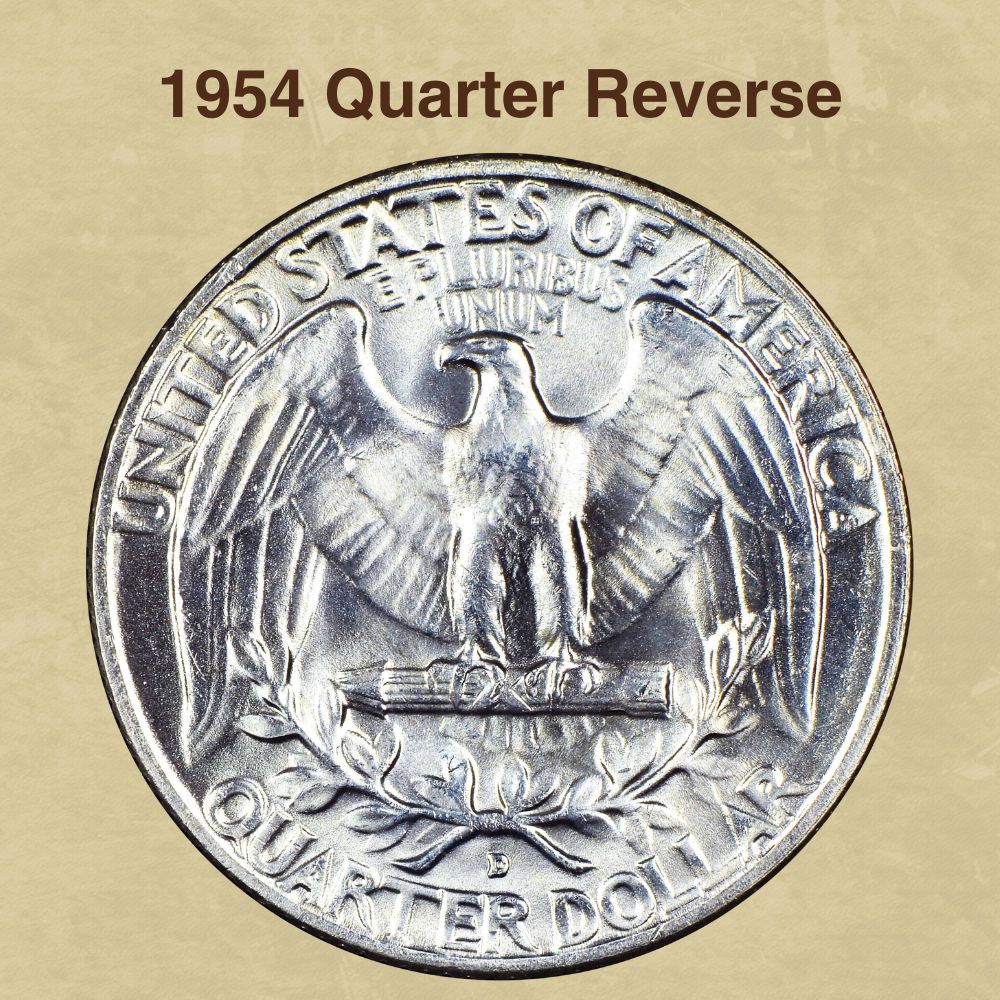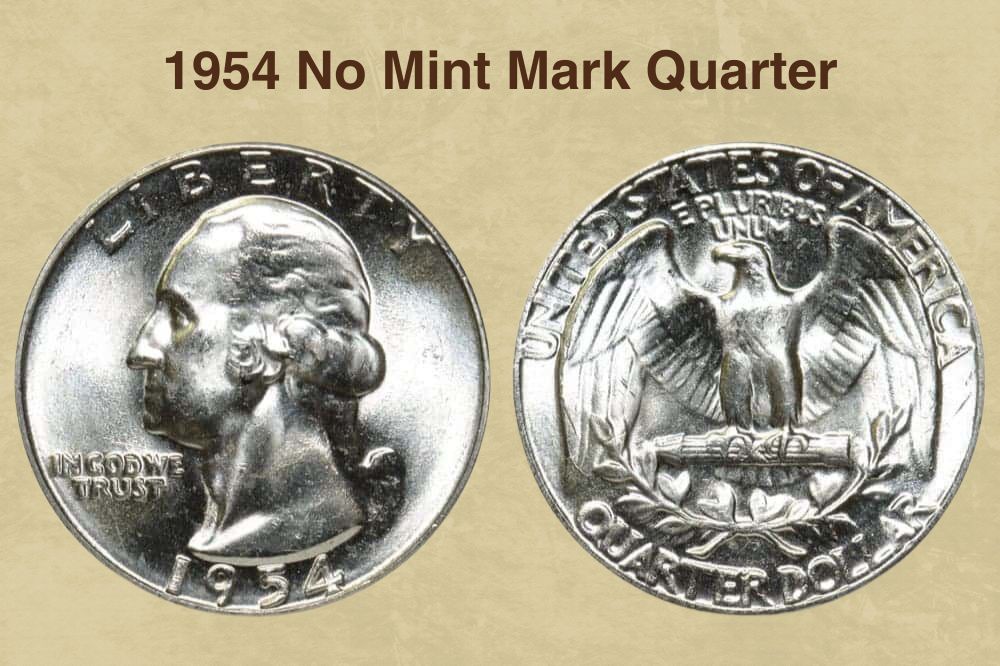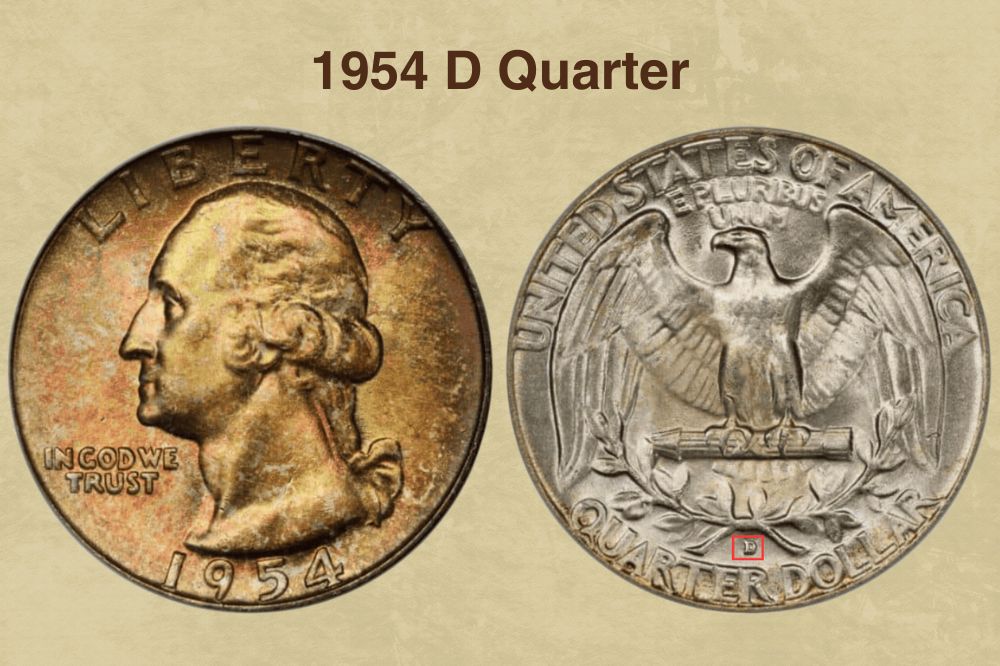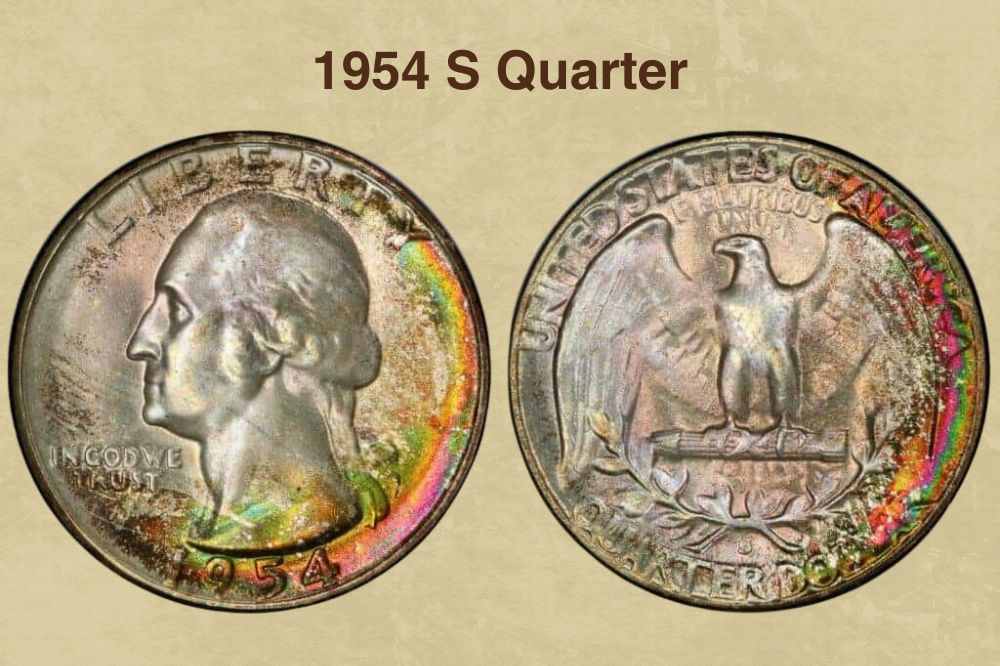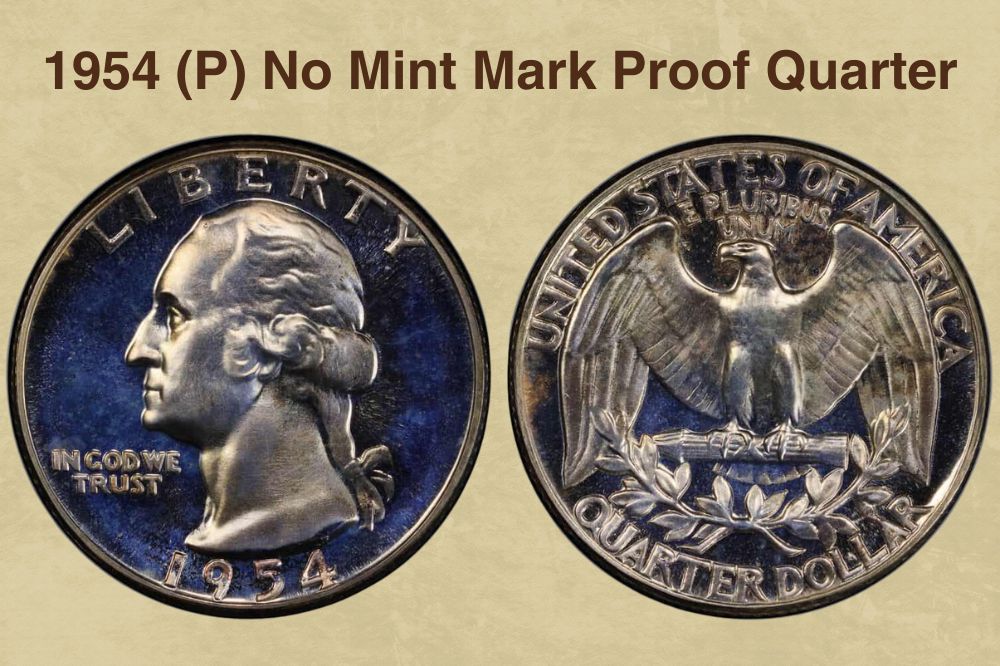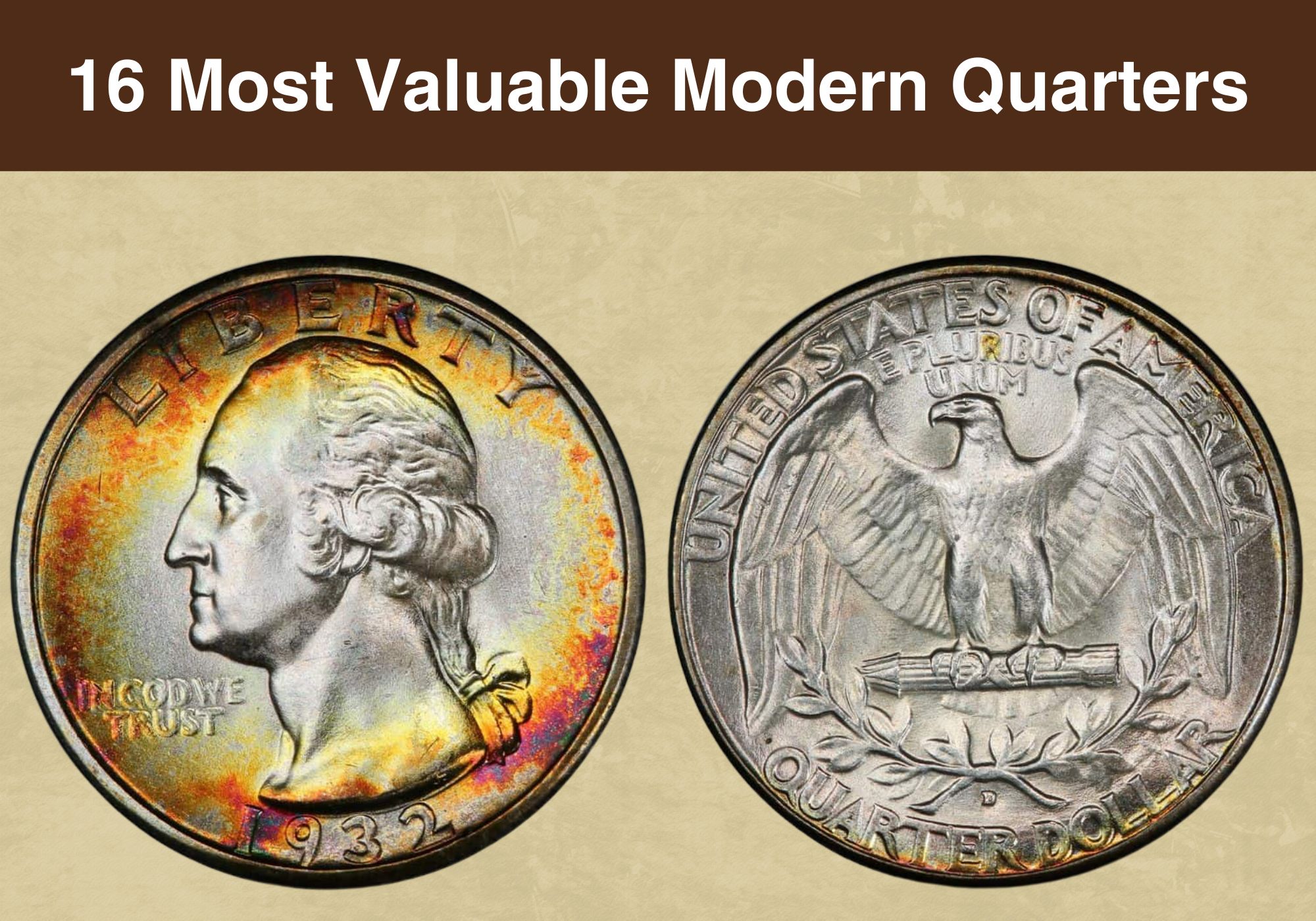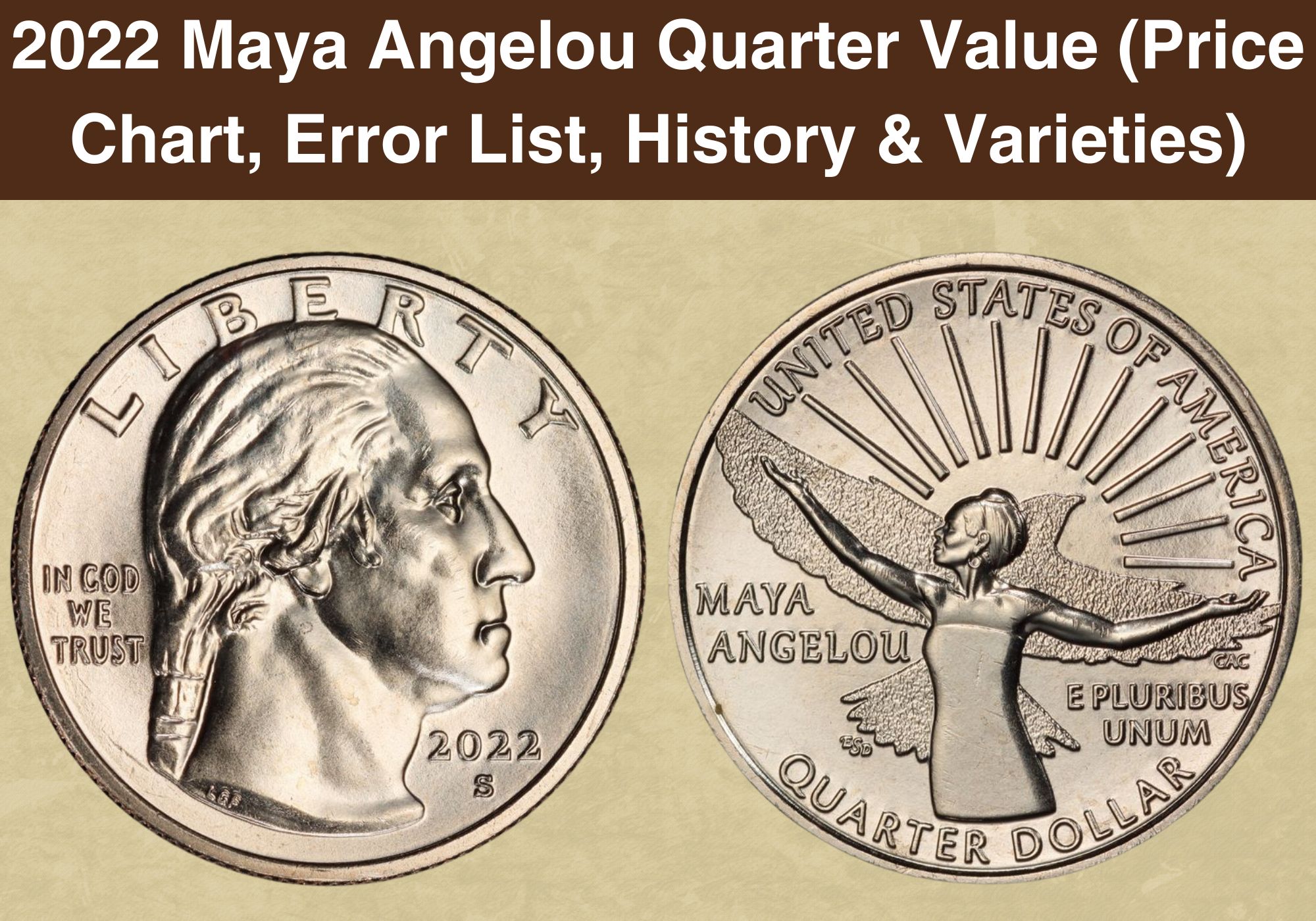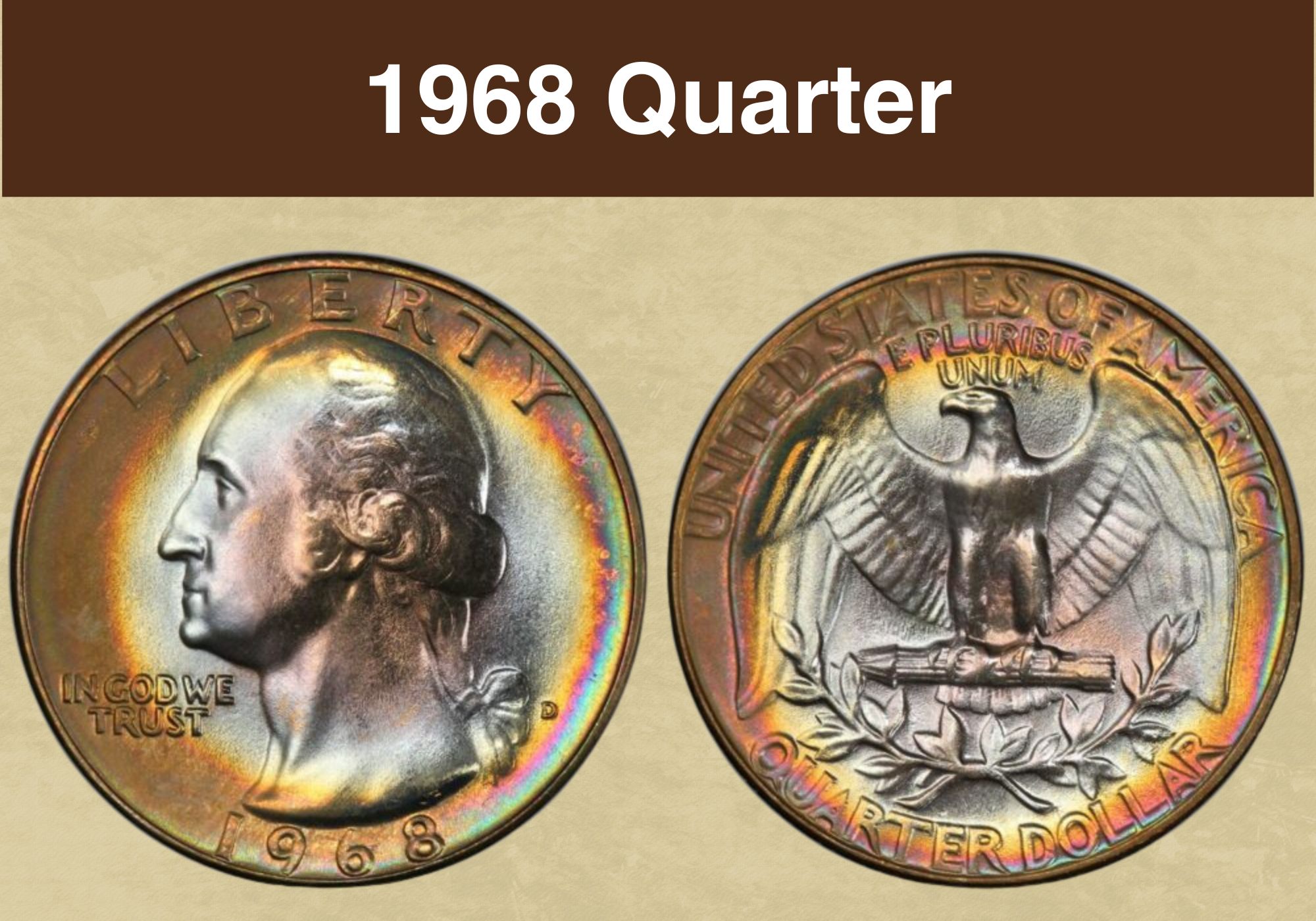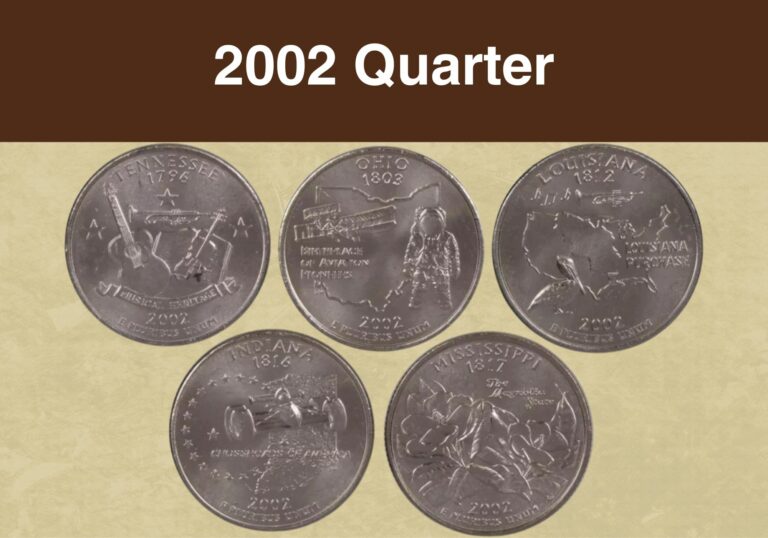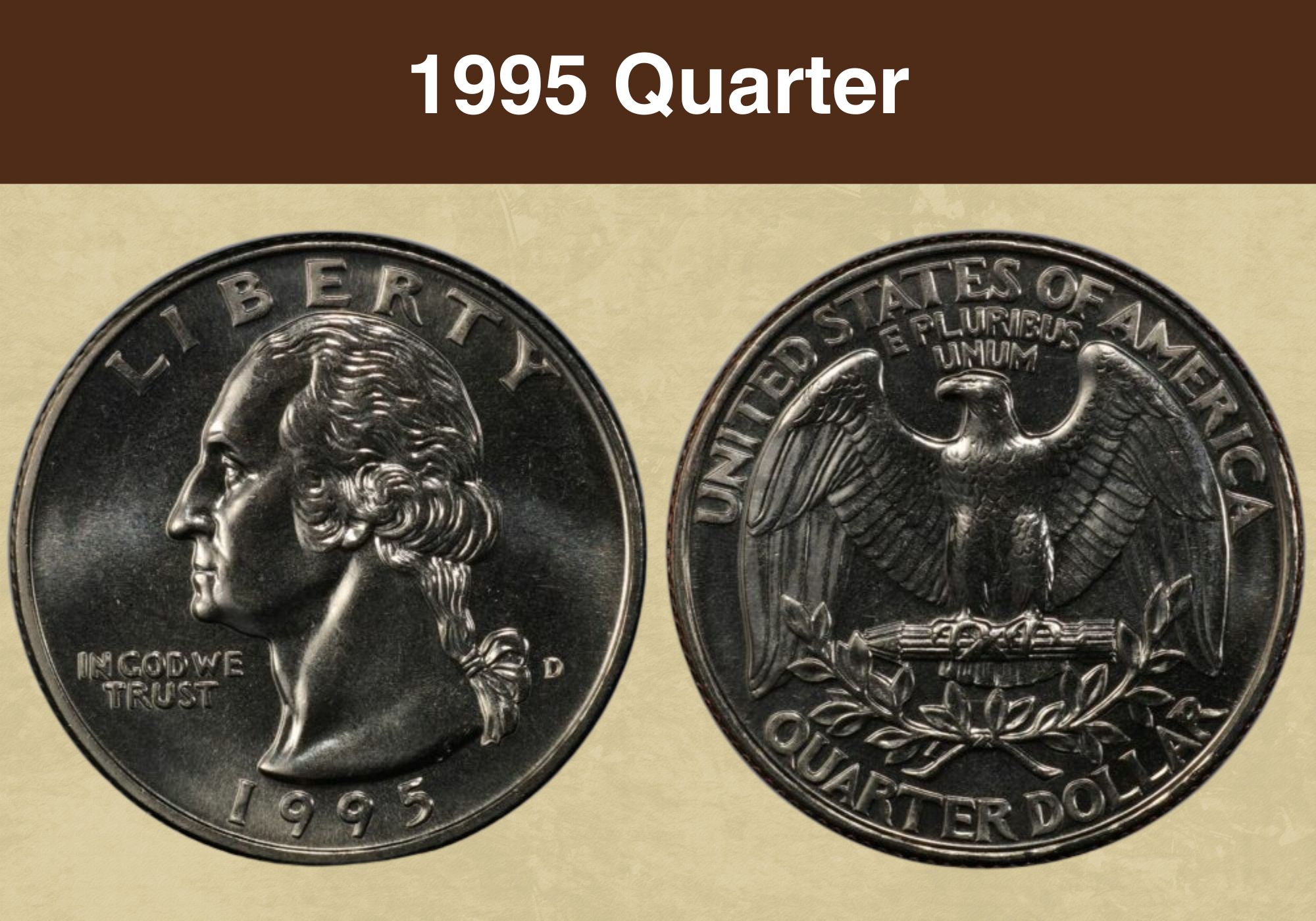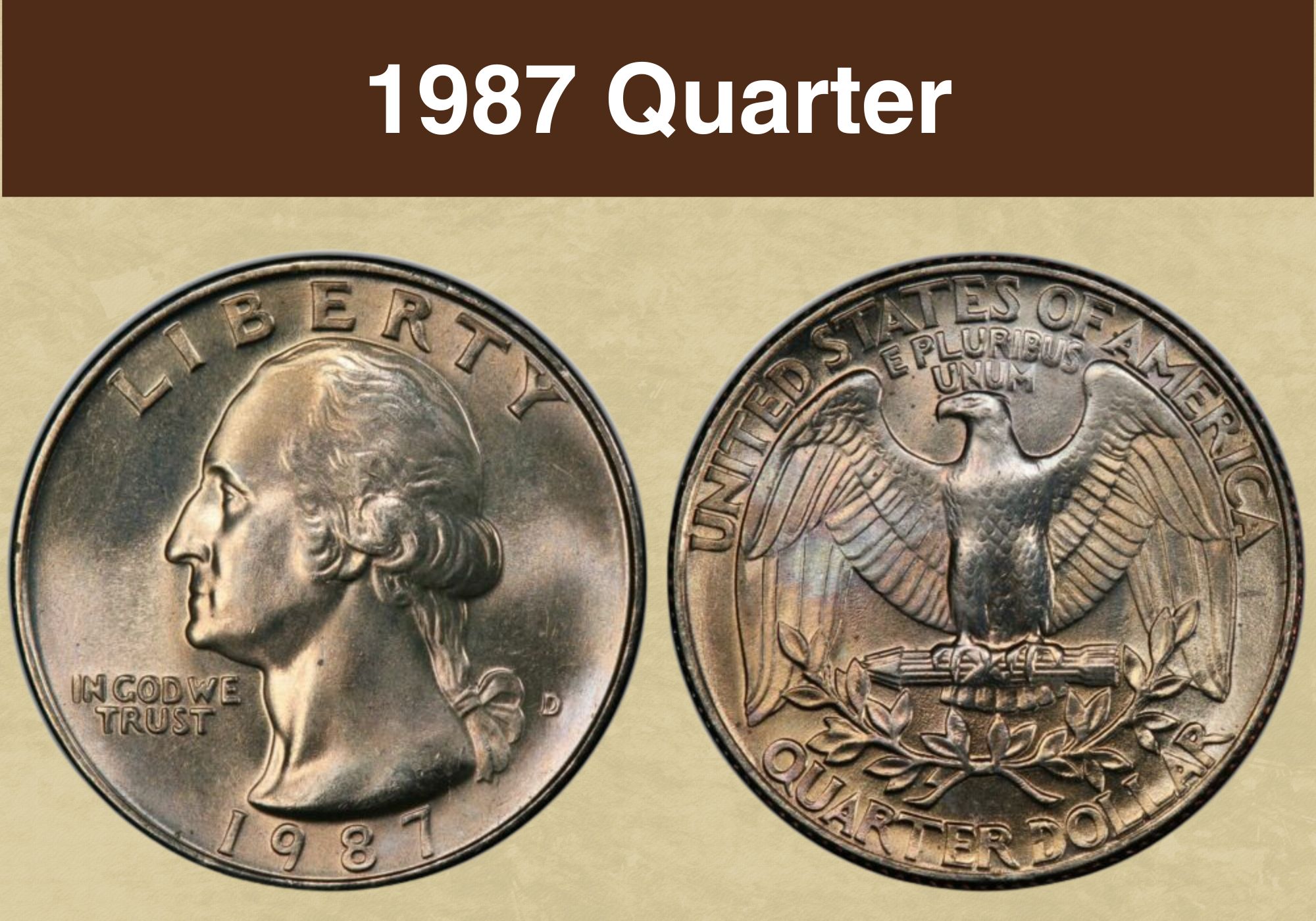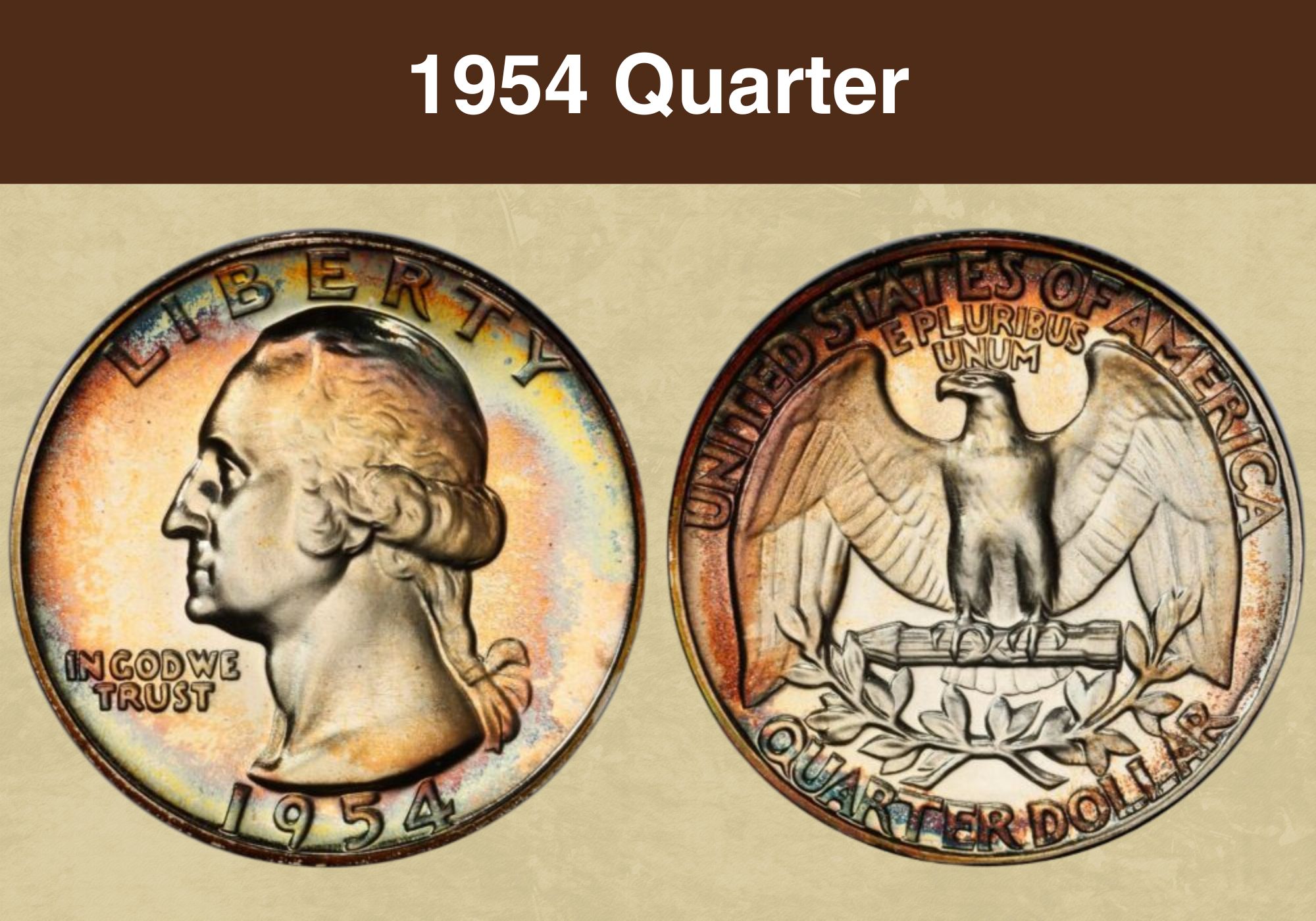
Coin Value Contents Table
If you’ve found a quarter dating back to 1954, you might be wondering what it’s worth. Or perhaps it’s a coin you’re looking to add to your collection, and want to know how much you should be paying.
Either way, you’ve come to the right place!
We’re going to explore the 1954 quarter value. We’ll find out how it’s affected by condition and mint mark. And we’ll look at some of the interesting Mint errors that can add a premium to the price collectors are prepared to pay.
Ready to learn more? Then read on!
| 1954 Quarter Value Chart | ||||
| Mint mark | XF45 | MS60 | MS65 | MS67 |
| 1954 No Mint Mark Quarter Value | $6 | $10 | $28 | $325 |
| 1954 D Quarter Value | $6 | $10 | $28 | $750 |
| 1954 S Quarter Value | $6 | $10 | $28 | $275 |
| PR60 | PR65 | PR67 | PR69 | |
| 1954 (P) No Mint Mark Proof Quarter Value | $8
Cameo: $18 Deep Cameo: $20 |
$26
Cameo: $18 Deep Cameo: $200 |
$50
Cameo: $115 Deep Cameo: $460 |
$1,000 |
History of the 1954 Washington Quarter
The 1954 quarter is one of the series known as Washington quarters. The first of those were struck in 1932. And they get their name from the image which appears on the obverse, or “heads” side of the coin. That shows the first US president, George Washington.
The portrait was the work of an artist named John Flanagan. But its selection has been the subject of hot debate over the years.
It had originally been intended to honor Washington with a single-year issue of a half-dollar. The coin was planned as part of a series of events to mark 200 years of American independence. And a committee was set up to oversee the arrangements.
It was that committee that selected a portrait of Washington for the coin – a work by an American artist called Laura Gardin Fraser. But then plans changed.
Instead of the half dollar, it was decided that Washington should appear on the quarter. And crucially, it would be a permanent addition to the nation’s coinage, rather than a one-off. That meant the decision on the design became the responsibility of the Treasury.
The committee wrote to the Treasury Secretary, Andrew W. Mellon, recommending the portrait by Fraser. But he preferred Flanagan’s image.
Before the coin was struck, Mellon left his post. The committee tried to persuade his successor, Ogden L. Mills, to reopen the decision. But Mills refused, and for the next 90 years, it was Flanagan’s portrait of Washington that appeared on the quarter.
In 2022, however, Fraser’s image finally got its turn. It is being used for a series of quarters honoring American women, which is due to run until 2025.
The first Washington quarters were made of 90 per cent silver and 10 per cent copper. That remained the case for over three decades, and all the 1954 quarters have the same composition.
But the 1960s saw silver prices rise significantly. And with coin production becoming ever more expensive, it was time for the Treasury to take action.
In 1965, silver was removed from the quarter. And since then, the coins have been made with a copper core. That’s clad in an alloy of copper and nickel to give them their silver color.
Because the new composition was harder, it was necessary to make slight modifications to the coin design. The relief was lowered to enable a good strike that would capture every detail.
Also read: Top 13 Most Valuable State Quarters Worth Money
Features of the 1954 Quarter
The Obverse of the 1954 Quarter
The obverse of the 1954 quarter is what gives it its nickname of the Washington quarter. It’s embossed with John Flanagan’s portrait of the first president of the USA.
George Washington is shown in profile, facing to the left as the coin is viewed. Flanagan’s initials are printed discreetly on the cut-off of the bust.
Above the portrait, the word “LIBERTY” arches to follow the upper coin edge. The date mirrors it, following the curve of the lower edge. And the motto “IN GOD WE TRUST” is to the left of the portrait.
The Reverse of the 1954 Quarter
The reverse of the 1954 quarter was also designed by Flanagan. It features a dramatic image of a heraldic eagle with outstretched wings. The bird is perched on a fletch of arrows, and below it is an olive branch, symbolizing peace.
The Latin phrase “E PLURIBUS UNUM” appears immediately above the eagle’s head. It means “From the many, one”, and reflects the creation of the country as a union of states. Above it, the name of the country curves along the top of the coin.
At the bottom, the denomination follows the line of the lower coin edge. It’s written as “QUARTER DOLLAR” in the same font and size as the country name.
If your coin was struck in Denver or San Francisco, it will also have a mint mark. Look for a small “D” or “S” below the middle of the olive branch, and above the “R” of “DOLLAR”. Coins struck in Philadelphia, however, don’t have a mint mark.
Other Features of the 1954 Quarter
The 1954 quarter measures 24.30 millimeters across and weighs 6.30 grams. It’s made mostly of silver, with a tenth of the weight provided by copper.
Turn it on its side, and you’ll see it has a reeded edge. The reeds are grooves which run perpendicular to the coin faces.
It’s a design that was first used in the eighteenth century. And besides being decorative, it has a practical purpose. It meant it was possible to see at once if any metal had been clipped from the coin edge, devaluing it.
1954 Quarter Grading Guides
| # | Grade |
|---|---|
| 1 | Basal State-1 |
| 2 | Fair |
| 3 | Very Fair |
| 4, 5, 6 | Good |
| 7, 8, 10 | Very Good |
| 12, 15 | Fine |
| 20, 30 | Very Fine |
| 40 | Extremely Fine |
| 50 | About Uncirculated |
| 60 | Mint State |
| 65 | Mint State |
| 70 | Mint State |
Please check our grading guides to know your coin scale, It’s the necessary step to know the exact value of your coin.
Check out now: How to Grade Washington Quarter?
1954 Quarter Value Guides
1954 No Mint Mark Quarter Value
In 1954, the Philadelphia Mint facility produced some 54.4 million quarter dollar coins. Today, the independent coin graders, the PCGS, estimate that around one in ten still survive.
The value of an individual coin depends largely on its condition. That’s graded from 1 to 70, with 1 being used for the poorest condition coins, and 70 indicating a perfect example. Uncirculated coins are graded from 60 upwards.
A 1954 Philadelphia penny graded XF45 – the letters stand for “extremely fine” – is worth around $6. If you’re looking for a mint state coin – one that’s never been circulated – values start at $10. And for a coin graded MS65 – the lowest level at which a coin is termed a “gem” – the value is $28.
So far, these are all quite modest figures. But for the very finest coins, you’ll need to pay significantly more.
At MS67, values leap into three figures, at $325. Half a point higher at MS67+, the value jumps again, to $2,100.
And the finest coins of this mintage to have been discovered to date are two examples graded MS68. The PCGS values those at a cool $10,000 each.
1954 D Quarter Value
The Denver Mint facility didn’t produce quite as many 1954 quarters as its Philadelphia cousin. Just over 42 million coins were struck there that year.
Survival rates are similar, with about 10 per cent of the original mintage still in existence. Around 50,000 of those coins are in mint state, with around 10,000 graded MS65 or above.
But coins at grades MS66 and above are considerably harder to find with this mint mark than either the Philadelphia or San Francisco quarters of the same mintage. All that is reflected in values.
An XF45 1954 D quarter is worth about $6, while at MS60 the value is around $10, and at MS65, $28. At MS66, the value doubles to $60. And an MS67 coin is worth much more – around $750.
The top grade for this mintage is MS67+. To date, the PCGS has certified seven coins at that level, and values them at $9,000 apiece.
1954 S Quarter Value
1954 quarters with the S mint mark originally numbered just under 12 million. But there’s a larger proportion of high quality survivors, with around 90,000 mint state coins remaining. And gem quality examples number around 26,000.
You can pick up a 1954 S quarter graded XF45 for $6, the same as the Philadelphia or Denver equivalents. Values at MS60 and MS65 are about the same too – $10 and $28 respectively.
At MS66, the value rises to $42, and at MS67, you’ll need to pay around $275. That’s considerably less than a coin of the same quality from either of the other facilities.
The finest examples of the San Francisco mintage to have been certified by the PCGS are graded MS68. The two coins at that level are worth around $13,500 each.
Rival coin grading agency the NGC has certified one coin at MS68+. That last sold at auction in 2020, when it fetched $7,200.
1954 (P) No Mint Mark Proof Quarter Value
In addition to the coins produced for everyday use, the Philadelphia Mint facility produced 233,300 proof quarters in 1954. These were created using special planchets and dies, and were aimed at the collecting market.
Proof coins come in three levels – standard proofs, cameos and deep cameos. Cameos are coins with an attractive contrast between mirror-like fields – the flat parts of the coin – and frosted devices. And with deep cameos, that contrast is particularly strong.
All other things being equal, a standard proof will be worth less than a cameo, which will in turn be worth less than a deep cameo.
Values start at just $8 for a standard proof graded PR60. That rises to $26 at PR65, and $50 at PR67. But if you want a best-in-class PR69 coin, you’ll be looking at a price tag of around $1,000.
The lowest grade for cameos is also PR60. The cameo designation triples the value at that grade to $18. And a deep cameo is worth just a little more, around $20.
For a gem PR65, a cameo will set you back around $45, and a deep cameo around $200. The finest cameos at the PCGS are graded MS68+ and valued at $650. The top grade for deep cameos at the PCGS is the same. The two coins certified at that level are valued at $7,500 apiece.
Also read: Top 16 Most Valuable Modern Quarters Worth Money
Rare 1954 Quarter Errors List
1954 (P) No Mint Mark Quarter, Struck on a 5 Cent Planchet
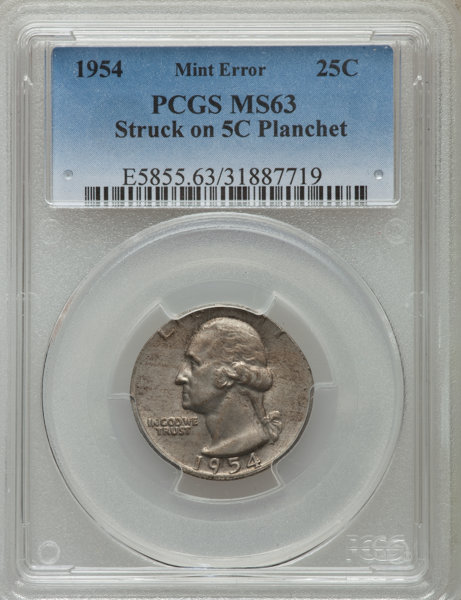
Very occasionally, coins are struck on something other than the correct planchet. This type of error is pretty rare, so the resulting coins are very collectible.
One such error occurred in 1954 at the Philadelphia Mint facility. One of the quarters was struck on a planchet intended for a 5-cent piece. The smaller planchet means that the design disappeared over the edges. And it weighed less than it should have too – 4.9 instead of 6.3 grams.
It was graded MS63 by the NGC. And when it was presented at auction, it sold for just under $2,000.
1954 (P) No Mint Mark Quarter, Struck on a Dime Planchet
The same kind of error occurred a second time at the Philadelphia Mint facility in 1954. In this case, the quarter was struck on a planchet intended for a dime.
The design again disappeared over the coin edge. Washington’s head pressed right against the upper rim. And the word “IN” from the motto “IN GOD WE TRUST” was lost entirely.
The coin was graded MS63 by the NGC. And it sold at auction for $1,700.
Also read: 17 Most Valuable Quarter Errors Worth Money
Where to Sell Your 1954 Quarter ?
Now that you know the value of your coins, do you know where to sell those coins online easily? Don’t worry, I’ve compiled a list of these sites, including their introduction, pros, and cons.
Check out now: Best Places To Sell Coins Online (Pros & Cons)
FAQs
Are 1954 quarters rare?
Plenty of the quarters struck in 1954 still survive today. And that’s the case whether they have a D or an S mint mark, or no mint mark at all.
But finding a coin in top condition is considerably more difficult. The very best examples are worth thousands of dollars.
Mint errors are, by definition, rare too. And a coin struck on the wrong planchet, for example, will command a significant premium.
What is the rarest date for a quarter?
Most of the mintages of quarters were produced in good numbers. But the 1932 D quarter is one of just two mintages numbering under a million. That makes this a key date for collectors of Washington quarters.

